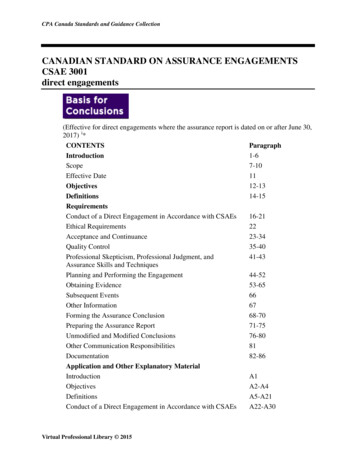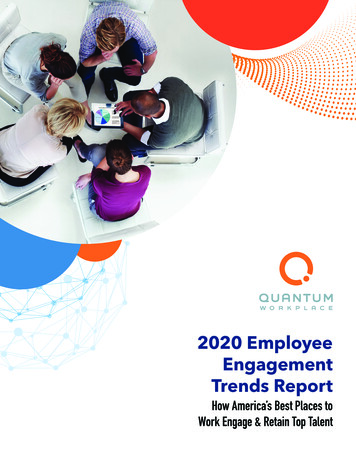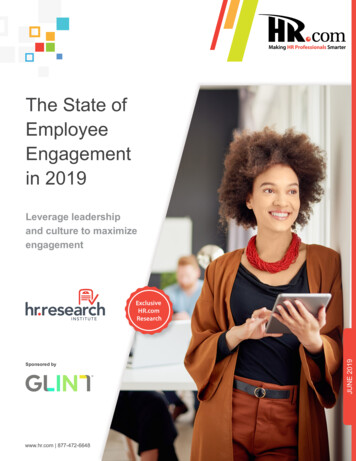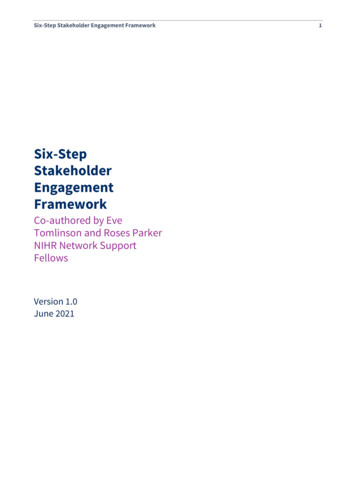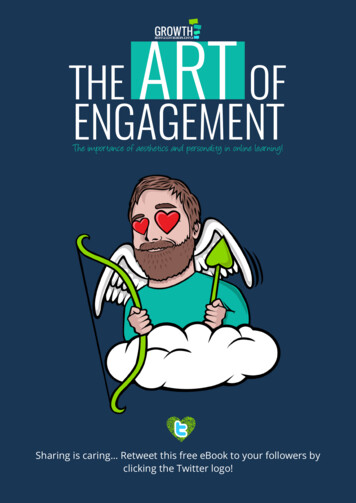
Transcription
THEART OFENGAGEMENTThe importance of aesthetics and personality in online learning!Sharing is caring Retweet this free eBook to your followers byclicking the Twitter logo!
Well hello, you beauties!Aren’t you looking lovely today?!This eBook, ‘The Art of Engagement’, will take a look at how the aesthetics, design and personality ofwebsites, platforms and all digital services and systems affect user engagement. We’ll discover therelationship between faces and engagement, how colours affect our perceptions, how a fun personalityand a humorous approach can attract – and keep – people’s attention, and the importance of cleverinteraction designs.We’ll start with the basics: what do we mean by ‘aesthetics’? Then we’ll explain how aesthetics andpersonality interact and reinforce each other to create powerful engagement, both in real life and inour digital lives. Keep reading to discover the Art of Engagement!AESTHETICSPeople are attracted to things that look nice: it’s a fact of life. From evolutionary aesthetics (we areattracted to humans with symmetrical faces, as this indicates health and vitality ) to buyingbehaviour (we like well-designed, beautiful things that will look nice in our homes and on ourbodies), we are interested in things which we perceive as pleasing to the eye.But aesthetics is about more than just looks. It’s as much about personality as how things appear – we’re not vainhere at Growth Engineering. They say, ‘Don’t judge a book by its cover,’ and we agree. A company can’t put all itsefforts into looking good and neglecting its substance; what’s the use in a beautiful, intriguing book cover whenthe content is bland and boring?But that’s not to say the cover should be ignored. It’s a great way to draw observers in and command theirattention in the first instance. Outward appearances and first glances can capture people’s attention and get theminterested in what you have to say. But it’s the combination of both – a beautiful cover coupled with an arrestingstory – that is sure to get people totally invested, completely engaged and in it for the long haul.So what are aesthetics, if not simply how things look? Well, there are a few definitions of the word, ranging fromthe study of what is artistically pleasing in appearance, to more theoretical explanations, including the philosophyof perception (that is, how we perceive things which are beautiful) and the psychological responses of thisperception. Let’s work from these theoretical points and see where we go FIRST IMPRESSIONSWe’ve all had experiences of positive – and negative – first impressions. We humans make very quick decisionsabout whether we want to get to know someone after spending just a few minutes in their company. These
judgements are based on looks, tone of voice, presence, characteristics and body language – the whole packageis quickly assessed.This is why speed dating is so popular: aside from the initial aesthetic reaction, talkingto someone for a couple of minutes can give you a brief idea of what they are like as aperson. For instance, an initial reaction of, “Wow, she is beautiful ” can then lead tothe conclusion, “She likes the same things as me! It’s so easy to talk to her. I want to getto know her better.” Bingo!Of course, this also works the other way around. What is desirable at first glance mayprove to be, as the boring book analogy suggests, disappointing: “She’s beautiful, butshe has no hobbies – how dull!” The disconnect between outward aesthetics andpersonality is jarring and results in wanting to take a step back; a cohesiveness between appearance andpersonality, on the other hand, is appealing, encouraging interaction and further investigation.First impressions aren’t just important in real-life interactions. In this digital age, it’s vital that websites, platformsand other service technologies make a good impression. Digital platforms have personalities; a specific tone ofvoice, an element of humour, favourite colours, preferred methods of interaction But in much the same way asa gorgeous looking man may be incredibly dull, a wonderfully-designed website may lack the depth to captureand keep a user’s interest.So what is it that’s missing when a website fails to engage the user? We think it’s the combination of personalityand looks: the true aesthetic, which takes into account not just how things appear, but how the design makes theuser feel and what it makes the user do.Take the example below: Leoneck Hotel in Zurich. Consider for a moment what you think and feel when you lookat this website. Do you get an understanding of the kind of hotel this is? Is it family-friendly, or aimed asbusinessmen? You may notice that the cursor is a cow, and the bell actually rings when hovered over clickablebuttons. Even the cartoon hotel has the name ‘Crazy Cow’ on it. Why do you think this is? What relevance does ithave to the personality of the hotel? Do they even know themselves?! Designs like this raise more questions thananswers!Consider this next website. Does it make a good first impression? Does it engage the user, make them want tospend time navigating around the site, clicking on links and purchasing the items? Does it heck! There’s nothingaesthetically pleasing about this website: it falls at the first hurdle. What kind of personality would you say thiswebsite has? Do you think it’s energetic and interesting? Welcoming and helpful? Clear and concise? Happy andexcitable? More like dull, dreary, confused and confusing!The design and aesthetics of a website lead you to make assumptions about it; about how well it might work, howreliable it is, and how safe it is to use – would you trust the company with your credit card details, or would youtrust them to fulfil their promises?
But don’t worry! All is not lost. There are good websites out there. Consider Zipcar (below), which is a website forpeople looking to carshare. Think about what kind of personality Zipcar might have – is it obvious from theaesthetics of the website?Do you get the impression that it is a friendly website that cares for you, that see you as a friend, and which wantsto help you find the right carshare? First-time visitors are greeted by Polo Pedro, Golf Gracie, A3 Andrew, TouranTegan and Transporter Terry – even the cars have personality! Feeling that you’re getting a guided tour around awebsite by these personalities helps get users engaged and invested. Why would they go anywhere else for theircar-sharing needs when they’ve already got to know Zipcar?But, as with cars, it’s also what’s under the hood that counts. Sure, the front-end of the platform or system maybe full of personality, engaging the users and getting them interested in what is on offer. But what happens oncethey’ve made the move from prospect to customer? Websites and platforms need to make sure that their brand’spersonality is present ‘under the hood’ too. Consistency is king when it comes to personality and aesthetics. Youwouldn’t stay friends with someone who is lovely when out and about but is boring and rude to you in privateonce you agree to invest your precious time in them!GET PERSONAL(ITY)!As we said, it’s not all about looks. Even the most beautiful website needsinteresting content and a good personality to really make it shine and standout among its competitors as ‘The One’.At the end of the day, the personality of a websiteis reflected in the user experience. A website maybe aesthetically pleasing but not easy to use –perhaps it has dead links, or is impossible tonavigate; maybe it is unclear which items areclickable. These factors will only serve to anger the user, and will result in a poor experience – thepersonality of the website will be seen as an annoying character; maybe even as a saboteur! “All I wantedwas to buy a new part for my x-ray gun! Why is this website not letting me do that!?”People look for unique, easy, fun and/or pleasant experiences when they deal with businesses – andthere’s no reason that what works in person can’t work online, too!
So how can you develop a good website personality that is attractive to users and makes them want toengage? Well, you need to think about what it is you want to convey; what you want the user experienceto be like.Think about what you’re trying to achieve. How do you approach your customers, users or learners?Make your approach unique and specific to your purpose.For instance, a website for a ski resort will show its personality through emotion-provoking, high-impactphotographs – such as a skier flying down a steep, snow-covered mountain – whereas a website for aspa will emphasise the calm nature of its personality with images of serenity, clean lines, relaxingphotographs and peaceful, fresh colours.A website for a bootcamp would soon fail if its personality was seen to be relaxed, quiet and slow-paced,yet these personality traits would work effectively for a website advertising a getaway retreat in thecountry. Think about it: does your brand’s personality shine through on the website?Once you’ve got the personality of your website, system, platform or digital service defined, all thedesign decisions should be made to match this personality.Clearly, aesthetics and personality are important in getting across the correct message to the correctpeople in the best manner. Getting the equation right will draw people in and encourage them to takea look around – just like a speed dater may be initially attracted to the appearance of their date, andthen decide, after talking to them for a couple of minutes, that they would like to get to know themmore.But how does this initial acquaintanceship develop to become a good relationship, with engagement –not necessarily the ring form! - involved?TREAT ‘EM & KEEP ‘EM!So you’ve caught the interest of someone – whether it’s a prospective love interest, a new user, a learneron your platform or a customer on your website. What is important in getting them to spend more timewith you or on your website?How can you cement engagement? Here are a few things we’ve found that are particularly important Faces: The presence of a face instantly works to engage. It’s simply part of being human: we are attunedto faces. In fact, we see faces everywhere, in plug sockets, cars and buildings; on toast, in clouds and intrees. So in touch with faces are we that our interpretation of words and phrases can be changed whenwe perceive them as coming from different people.When looking through the next couple of pages, consider what the phrase, ‘Keep on moving,’ may neachinstance.
KEEP ON MOVING!KEEPONMOVING!KEEP ONSo what did you think? Was the homeless man speaking ofMOVING!up in his struggle? What about the young woman? Perhapshis need to keep moving through the streets, to not giveshe said it to encourage others to get off their backsidesand get fit, or to enjoy life more. And what of thebusinessman? Could he have intended the phrase to helpothers to see that they too can be successful if they justkeep on going and moving up the ladder?The face – and therefore person and personality – weattribute the quote to dramatically changes the meaningof it, such is the importance of faces to our perception.Hopefully you can see the importance of faces and thepersonalities we ascribe to everything related to faces.This is why utilising people and faces – as avatars, or inphotographs, on ‘About Us’ pages and in eLearningscenarios – is such an effective way to get users and learners engaged and get them really invested in your cause.Colour: What’s the colour of a Mars Bar? How about a can of Diet Coke? What colours do you associate withSainsburys? Growth Engineering? Vodafone? I’m sure we all know! Colour has an amazing ability to affect how wefeel and how we perceive the world.Colours are associated with feelings and ideas; blues are cool and calm, reds are passionate , orange is warm. Thecolours you use for your website or platform can significantly affect that all-important first impression. Thinkcarefully about what you want to be known for; what you want to represent, and what feelings you want to elicitfrom people who view your website or use your system.It’s no wonder that visitors to www.growthengineering.co.uk feel trustful that we are dependable and strong,encourage growth and aim to help improve people’s lives – just look at what our brand colours are universallysaid to represent!
BE DELIGHTFULLighten up! Be interesting. Surprise and delight everyone who visits your website, logs on to your platform or usesyour service. You’re never as boring as you think you are. Your brand has a personality that’s reflective of itsprinciples, ideals and vision – work from the idea that these are interesting to others! If you’ve spent timedeveloping your personality or brand, don’t stop now: it should be reflected in all aspects of your design.Say what you want to say in the most exciting, engaging way possible, which best reflects your wonderfulpersonality. Which of these popups is more engaging, do you think?
It’s a no-brainer. Use humour when it’s appropriate and you’ll see an increase in user engagement. Of course,don’t crack jokes if it’s not reflective of your brand’s personality, but if you can get away with it, injecting a littlehumour into the design and the website content really captures the attention of people who may otherwise havebounced straight back off.Beauty, fun and pleasure interact to make an experience enjoyable. So be beautiful, make things fun andentertaining, make the experience enjoyable and reap the rewards of getting everyone who lands on your pageor platform completely engaged!DOWN TO EARTHHow long would you spend in the company of someone who spoke only in acronyms? Or who called everyone bytheir binary name (we are 01000111 01110010 01101111 01110111 01110100 01101000 00100000 0100010101101110 01100111 01101001 01101110 01100101 01100101 01110010 01101001 01101110 01100111, by theway!)? Right – not very long at all! So why should you expect your users, learners or customers to spend theirprecious time trying to interpret all your technical language? Websites and platforms that do this put a huge wallup that only the most dedicated, fearless people will be able to clamber over.Don’t make things harder for yourself than they already are. There are so many choices out there in cyberspace,so when potential customers land on your page, or learners reach your platform, don’t put extra barriers in theirway. Don’t make them get out the dictionary just to find out what it is you do. Don’t make them feel stupid. You’rea friend – you’re providing a service, making their world a better place, helping them to become whoever theywant to be. There’s no need to be pretentious about it!“ALL THE WORLD’S A GAME.”Now if we could just remember who said those wisewords Answers on a postcard, please.So what’s the big deal with games? Why shouldwebsites try to keep their audiences entertained? Well,as we said before, it’s fantastic to be fun and includeelements of humour, and making a game out of toughor boring things to make the experience morepalatable is a great idea to keep the user, learner orcustomer on your side!You can use gamification to revive a dull website by rewarding badges and achievements for navigating andexploring, or for filling in forms, posting questions, downloading articles or sharing content on social media.Google is an example of a company that is always thinking up fun ways to entertain its users. Type ‘tilt’ into Google.Do you see it? How fun! Now try ‘do a barrel roll’ and watch the world spin! Adding gems like this – or ‘Easter eggs’,as they are known – to a search engine makes it that much more exciting and engaging. Discovering fun gamesand cool new tricks that you wouldn’t have expected makes the website memorable and will encourage users to
return to it to discover more. But be careful The user needs to understand the fun and games. A moo-ing cursorwith a jingling cowbell may just confuse them As you may have gathered, we’re really into our gamification here at Growth Engineering. We’re really proud ofthe gamification features and fun activities we’ve built into our Academy Platform. In fact, we find gamification sointeresting that we’ve written quite a lot on the subject: click here to download our free guide on how to improveengagement with gamification! Now, back to business DON’T COME ON TOO STRONGSeriously. The speed dater doesn’t want to know where your parents were born, or what you hadfor dinner last Tuesday night. They also – probably! – don’t want to give you their home addressand be bombarded with post on all kinds of irrelevant topics. Sound familiar? Oversharing andacting like a stalker is a sure-fire way to lead to heartbreak – and disengagement.So instead of stalking or shouting about what you do, trying to forcibly drag the user back to your website againand again, try this: highlight the benefits. Be friendly. Look nice. Work efficiently. Don’t just talk about yourselves.Be happy. Show off your personality. If you make the user want to come back to you, you’ll have nailedengagement. Don’t chase them: get the art of engagement right and they’ll always come back for more.BE INTERACTIVEYour website, Learning Management System, platform or service cannot simply look good and reflect the brand’spersonality. It must also work well. That doesn’t mean it simply achieves its aims – of course it should sell a lot ofproducts, get a large number of new contacts or successfully train up a workforce – but it should also be a pleasureto interact with and work on. It should not be too difficult to manoeuvre around or learn how to use; usersshouldn’t have to spend their time mastering the device, website or platform – their time should be spentmastering the content.Interaction design (often abbreviated to IxD) is all about getting digital things shaped perfectly for people’s use.The aim of IxD is to create a digital website, service, system or platform that satisfies the needs and desires of themajority of users. Getting this right – in combination with pleasing aesthetics and a fabulous personality – reallyis the art of engagement.So what can you do to improve your IxD? One way, which complements your campaign to overhaul your system’saesthetics and personality, is to focus on affective interaction design. Keep in mind when you’re designing yourwebsite that whatever you decide will elicit emotional responses from users. For example, using dynamic icons,sounds and animations can help convey a sense of urgency or operation; that the user or learner needs to dosomething. Make the emotions elicited by the interaction in-line with those elicited by the aesthetics; lively cartoonanimations will look out of place on a website that sells black and white photographic prints, for example. But ifthe brand’s personality is fun, exciting and full of wonder, a cartoon character helping to guide the user aroundthe platform will work well.
Returning to the Leoneck hotel we saw earlier The cow cursor here doesn’t make much sense. But imagine if thewebsite was for Leoneck farm. In this instance, a cowbell ringing cursor makes perfect sense and complementsthe personality of the farm wonderfully!Interface design choices like fonts, colours (as we’ve seen) and screen layouts can also have an im pact onperceived effectiveness of a website. Indeed, research has shown that people will judge an aesthetically-pleasingwebsite to be much easier to use than a plain, boring one – even if there is no true difference between the two.Now that’s really something.CONCLUSIONSo what have we learnt about aesthetics and the art of engagement? Well, it’s not just about looks; and it’s notjust about personality. It’s the combination of the two, and the interplay and relationship between them that reallyencourages engagement.Take the website, platform or whatever digital system you are working with, and make sure that it works well,displays the correct personality, is aesthetically pleasing, easy to use, is fun and is, ultimately, the kind of personyou would want to get to know.That is the real art of engagement. Good luck.Thanks for reading! Don’t forget to share:Want to find out more? Select your question below to download your free guide!WHAT ISHOW CAN I ENGAGEHOW CAN I RESOLVEGAMIFICATION?MY EMPLOYEES?CONFLICT AT WORK?CONTACT US:If we’ve piqued your interest, we want to hear from you!Connect with w.growthengineering.co.ukVisit us!44 Peascod Street,Windsor, Berkshire,SL4 1 DEEm ail us!hello@growthengineering.co.ukCall us!01 7 53 840 331
How can you cement engagement? Here are a few things we've found that are particularly important Faces: The presence of a face instantly works to engage. It's simply part of being human: we are attuned to faces. In fact, we see faces everywhere, in plug sockets, cars and buildings; on toast, in clouds and in trees.




